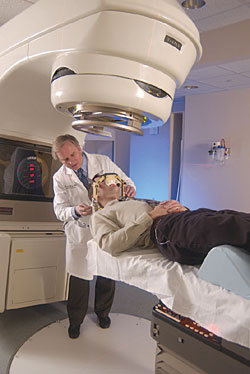Focused radiation means less damage, more chance of cure
Since the first cancer patient was treated with radiation therapy in 1896 (the same year that the first clinical x-ray in the nation was taken at Dartmouth), techniques for killing tumors with focused energy have changed dramatically. Today, half of all cancer patients receive radiation treatment to kill cancer cells and control their spread.

|
|
Radiologist Eugen Hug adjusts DHMC's
new radiotherapy device for a patient.
The massive instrument stands nine
feet tall and weighs almost 10 tons. |
Beams: The problem is that conventional radiotherapy—in which a medical linear accelerator delivers large, uniform beams of radiation to a tumor site— may not only kill cancer cells but also damage healthy tissue surrounding the tumor.
But now, "recent advances in computers and technology have enabled us to increase and focus radiation where we need it— with less radiation to surrounding tissues," says Eugen Hug, M.D., chief of the Section of Radiation Oncology and associate director of DHMC's Norris Cotton Cancer Center. "Today we can deliver a higher dose, decrease side effects, and increase the chance of cure. We were not able to do this for many patients 10 years ago."
Precise: In May, DHMC doctors began treating patients with Intensity Modulated Radiation Therapy (IMRT), which uses computer-generated images to plan and deliver a radiation dose precisely the shape and depth of the tumor.
A computer-controlled device called a "multi-leaf collimator" uses up to 120 tungsten fingers, or leaves, to sculpt the radiation beam to conform to the tumor. The linear accelerator can also be moved to target all dimensions of the tumor.
Tissues: "Splitting the tumor into different segments improves dose delivery and increases the chance of completely eliminating the tumor," Hug explains. "IMRT can be custom-tailored to the requirements of the tumor and the critical normal tissues around it."
Studies have indicated that IMRT is especially effective in treating tumors of the brain, head, neck, prostate, and lung. With conventional radiotherapy devices, it's difficult to deliver radiation to tumors located at those sites in doses that are high enough or that don't result in severe side effects.
Mary Hawkins
If you would like to offer any feedback about this article, we would welcome getting your comments at DartMed@Dartmouth.edu.
